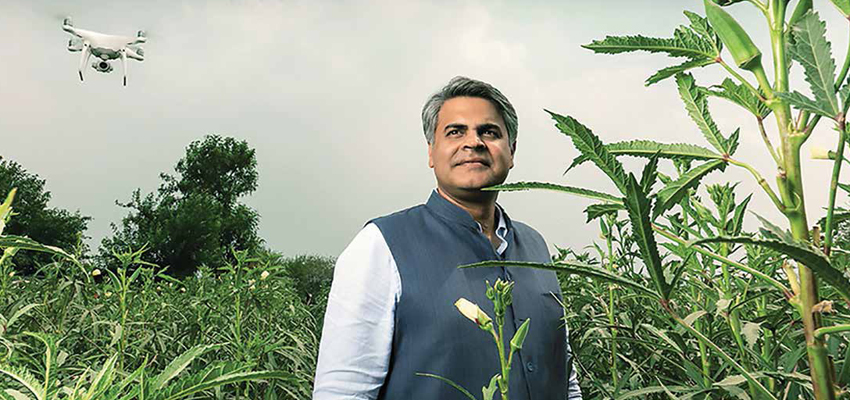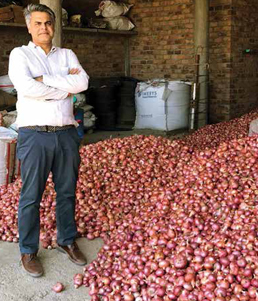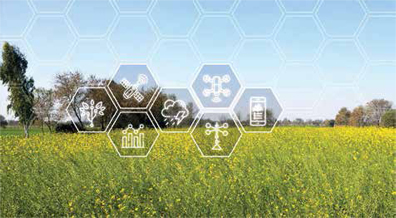Dynamics of ‘Weather - Driven’ Business

Depicting the forces behind Cyclone Vayu or Cyclone Fani, predicting the Kerala pre-monsoons, analysing of troughs, thundershowers, weather warnings or other weather-related manifestations, no longer seems to be clouded under a ‘storm’ of unpredictability. While the Indian Meteorological Department (IMD) is competent with its weather ‘vane’, companies like Noida-based Skymet Weather Services Private Limited, have added a dimension to the gamut of weather forecasting and lent more dynamics to agriculture risk monitoring. The brainchild of Founder and Managing Director, Jatin Singh, it provides weather services and graphics to media houses in India, also, to the insurance, power and agriculture sectors. With its software tools supporting weather and climate decision systems, their weather website too enables access to accurate weather information. The Skymet app claims to be the first ‘Made in India’ app providing weather information in multiple regional languages. Corporate Citizen explores the dynamics of this ‘weather-driven’ business

I have always been fascinated with weather phenomenon and how they seemed to defy all expectations, all predictions,” said Jatin Singh, Founder and Managing Director, Skymet Weather Services Private Limited. It was this thought process that germinated the idea of collating significant weather-related data and enabling other businesses that depend on weather forecasting for their growth and sustainability.
The company operates via three primary product segments – Skymet Weather Information System (SWIMS), Agriculture Risk Monitoring System (ARMS) and SkymetOne- a one-stop-shop for buying weather, crops and monsoon related data. It has since innovated areas of the weather forecast, weather warning and climate change adaptation. These innovations work on models that utilise Data Acquisition, Data Analysis and Data Dissemination systems for comprehensible information nuggets to help usher in an approachable network between the farming and allied sectors.
How’s the weather today?
Jatin’s tryst with forecasting weather began at the age of 17. Thanks to his father’s associations with the Indian Meteorological Department (IMD), Jatin understood the competent technology provided by the IMD. However, his realisation on the importance of data-driven weather mapping gained track as a broadcast journalist with a prominent media house.
“I understood that getting data from IMD was a task. Also, data from IMD arrived as a cyclostyled sheet with a chart that showed maximum and minimum temperatures. The days of 24-hour news channels were just beginning, and they were looking to make weather forecasts more appealing. That was when I realised that there was a market for data that could be readily available and easily understandable,” said Jatin Singh.
The ‘Rain Man’ cometh!
While Skymet found some conceptual footing in 2003, Jatin began forecasting monsoons in 2012 after he met the ‘Monsoon man of India’ -D.R. Sikka. “The growth was good as my first assignment was with the Sahara channel giving them re-packaged forecast and then I soon grew to all media houses-the likes of The Hindu, Mid Day and the Hindustan Times. All of them still use Skymet data,” he said.
As is with most indigenous forays, Skymet too started from a single small room when Jatin would jot down IMD’s forecast and apply Adobe Photoshop to create appealing visuals for the broadcast medium. A grant of Rs.25 lakh in 2010 from Villgro, India’s oldest social enterprise incubator set the ball rolling. The following year, an agri-tech venture fund, Omnivore Capital, backed by the Godrej Group, invested $1 million in Skymet, which created the fund’s first investments in India. Their model is primarily investor-based without any partnership roots.
Skymet made its first prediction sometime in 2012. “However, that was also the time when the Indian economy was witnessing a slow down just when investors had started to come in; we then moved into instrumentation. In order to differentiate Skymet from any other run of the mill weather company, we needed to make use of the best that technology could offer. Till date, Skymet has installed 6500+AWSs (Automated Weather Stations) and over 20 lightning sensors across the country,” said Jatin.
The company’s revenue stands at INR 40 crores (2018). “There’s no one today who can match the gamut of all our offerings-agri-tech as well as weather. We are a one-stop platform where we acquire, analyse and disseminate weather information and agri-advisory, ” he said.
“There is an increasing need for the digitalisation of Indian farming and innovative ideas to realise our goals. Youngsters with unique business solutions to India’s agricultural woes can find willing investors in the present scenario”

Weathering the agri sector
Interestingly, Skymet is well-entrenched into the rural sector. A ‘boon in disguise’ perhaps, and as a result of the tremendous information gap that threatens the rural sector.
The agrarian state of our economy prompted a seamless transition of Skymet’s weather mapping expertise to help forecast weather for agricultural outputs. “The average Indian farmer is still dependent on the vagaries of monsoon. Accurate and timely weather forecasts can help the farmer make informed decisions. Through various channels we try our best to make sure that the necessary information reaches the right person, at the right time,” he said.
To address the rampant occurrences of farmer suicides’, Skymet’s attempt to devise products and means for knowledge building is steered towards alleviating some of the agri-related problems. Linking cost-factors and insurance covers has been another way to help strengthen the rural sectors’ approach to farming.
“People in the rural areas are very misinformed about insurance and through Skymet’s sister company, GramCover, we facilitate the required information regarding insurance to them. We have devised a digital model for this which reduces the cost to a large extent,” said Jatin.
“Through accurate weather forecasts, we help the farmer transition from archaic methods. If losses incur, then the farmer can make use of insurance to bounce back. Through GramCover, we facilitate information not only about crop insurance but also about micro- health insurance and personal accident insurance too,” he added.
“Despite the most impressive technological advances, nature remains predictable only in its unpredictability. Even the most experienced meteorologists cannot guarantee a predictability success rate of beyond 70% to 75%. And when the forecasts go wrong, no matter how rare an occurrence, people are quick to write you off”
Underlying CSR
Jatin explains that Skymet’s endgame is not limited to mere generation of data. “The smallholder farmer in India is both economically and educationally disadvantaged. Consequently, they cannot make use of the information that the country’s think-tanks generate for better yields in farming,” he said.
And, it is this thought process that has led Skymet to not just disseminate relevant information, but also attempts to educate the farmer through a wide network of informed field agents and through events which encourage the development of a community to practice these. “We also analyse and disseminate that data so that it can make some real impact,” he said.
One of Skymet’s partnership steers a project funded by the USAID (United States Agency for International Development) titled ‘Partnership in Climate Services for Resilient Agriculture (PCSRA) in India’. “PCRA is a four year (2015-19) unique partnership programme between USAID and Skymet which aims to make climate information, risk mitigation tools and advisory services, more accessible to Indian farmers making them resilient towards weather- driven risks,” said Jatin.
Beyond farm forecasts
Skymet’s client base covers Non-Banking Finance Companies (NBFC), banks, insurance companies, the energy sector, besides its stakeholders in the agri-industry. “About 80% of our revenues come from servicing clients engaged in the crop insurance business. However, none of the segments are lucrative enough because the forecast does not really generate revenue. But, we have been able to build a huge data bank of weather and crop information which will be very valuable in the near future,” said Jatin. He is however gung-ho on the power sector which he believes has the potential to maximise revenues, followed by agriculture and the media and communication industry.
“A lot of agri-insurance settlements are done through us. Farmers get their insurance settlements on bad weather through our services very quickly, because the data is live, and there is no time delay between us getting the data and transferring it to the insurance company,” he said.
In a highly diversified environment, Jatin’s business relies a lot on the old-world-‘word of mouth’ appeal. “We employ a wide network of field workers who talk to the farmers directly and try to explain to them the benefits of using weather-based advisory. We recently did a campaign on the radio in Maharashtra and Kerala to make people aware of the incoming floods expected in these regions. We participate in B2B (business to business) or peer to peer platforms too,” he added.
Skymet has also tapped the non-conventional track with a considerable following on social media platforms. “We have already generated some 70,000 followers on twitter, 60,000 ‘Likes’ on our Facebook pages and around five lakh subscribers on YouTube channel”, he added.
The company maintains academia connect too, to encourage newbies into this field too. “We have worked closely with institutions like IIMs, JNU and the Amity chain of schools and colleges for conducting workshops to create awareness about climate change, climate resilience and agriculture.
“It’s a hard place to be, we all want to do good for farmers but the biggest investor here is the government. The stability of the government and belief of people in the incumbent government makes or breaks our trust”, said Jatin.
He believes that while now is the optimal time for the sector, more wherewithal’s are necessary. “There is an increasing need for the digitalisation of Indian farming and innovative ideas to realise our goals. Youngsters with unique business solutions to India’s agricultural woes can find willing investors in the present scenario.”
However, he warns that weather forecasting can be a tricky business. “Though it’s not pure science and can never guarantee a 100% accuracy, experience and knowledge are a must. Only with the aid of weather charts and weather models, can you generate accurate weather data. Never be too hasty and impatient in your approach”, he said.
Climate-Change management
The largely monsoon-lead agri-sector in India harnesses itself between long dry spells, followed by periods of excessive rainfall leading to floods. On the flip side, there are drought and flood situations occurring in the same season in the same region. This makes it very tricky for the average Indian farmer to deal with these repercussions. Jatin explains, “With Skymet’s accurate and timely forecasts, the farmer can make more informed decisions. One way to mitigate the risk for all the stakeholders in the agriculture sector is agri-insurance. Due to the tremendous information gap, most Indian farmers are left vulnerable to the consequences of crop failure. We work with insurance compacompanies and through our sister company, Gramcover, to facilitate the dissemination of insurance information to the farmers.”
Extreme weather upheavals have the potential to wreak havoc on food production. Skymet has therefore devised crop yield assessment projects.
“The company has teamed up with food storage companies to avoid a Malthusian nightmare. Skymet is an implementing partner of the project funded by USAID (United States Agency for International Development) titled ‘Partnership in Climate Services for Resilient Agriculture (PCSRA) in India’ which aims to make climate information, risk mitigation tools and advisory services, more accessible to Indian farmers making them resilient towards weather- driven risks,” he said.
“A lot of agri-insurance settlements are done through us. Farmers get their insurance settlements on bad weather through our services very quickly, because the data is live and there is no time delay between us getting the data and transferring it to the insurance company”
Ground reality
However, Jatin very well understands the ‘Hand of God’ in a business that cannot sometimes be justified under logical or scientific parameters. He said, “Despite the most impressive technological advances, nature remains predictable only in its unpredictability. Even the most experienced meteorologists cannot guarantee a predictability success rate of beyond 70% to 75%. And when the forecasts go wrong, no matter how rare an occurrence, people are quick to write you off.”
But, he is confident that he can steer on in a market that has its own gaps. “While we don’t have any direct competition in our gamut of offerings which includes agri-tech and weather forecasts; there exist players such as IBM, Accuweather which are strictly into the weather business. In the agri-tech business, the only other player is a company called Agro Star.”
In an environment of global warming debacles – Skymet’s “From the sky to the ground”, is a brave statement to weather!